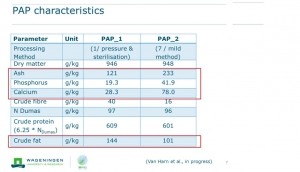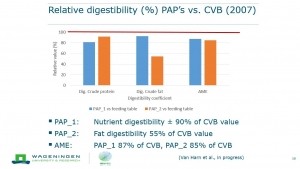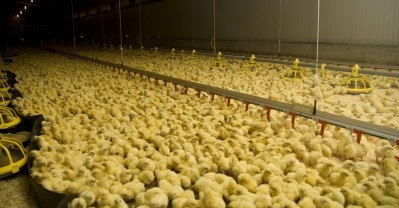Reports from VIV Europe 2018
Nutritional reappraisal of PAPs underway as their use in EU feeds is expected

The focus of the event, in particular, was on the sustainability benefits of animal fats, meals and animal based phosphates and how recycling of by-products in feed can really close the circle.
The event saw Marinus van Krimpen, animal nutrition researcher, Wageningen Livestock Research, presenting on the results of the nutritional evaluation work that himself and his colleague, Jan van Harn, have been carrying out on processed animal proteins (PAP) and phosphates in poultry.
Currently in Europe, there are regulatory restrictions on the use of animal by-products in livestock feed. Perhaps, though, legislative change is in the works.
Since 2010, van Krimpen’s work at the university has focused on the search for alternative protein sources for animal foods, improving the phosphorus and nitrogen efficacy of pigs and poultry, boosting bird welfare and stimulating immune competence through nutrition.
The PAP studies he and his team have been undertaking in poultry have been funded in the main by industry players: rendering trade association, EFPRA, and animal meal and fats suppliers: Darling Ingredients and Saria.
[The abstract summarizing the team's evaluation of the use of PAPs in layer diets can be reviewed here)
The researcher believes PAPs will be reintroduced into poultry feed in the EU soon.
He told FeedNavigator: “The EU would like to increase its rate of protein self-sufficiency, to become less dependent on [imports] from South America. DG Santé is currently working on a proposal that would allow the reintroduction of pig PAP in poultry diets. This could be realized within a rather short period (perhaps one year). After this, they will work on the reintroduction of poultry PAP in pig diets.”
Due to the species to species ban, one condition for the use of PAPs in poultry feed in the EU is that they would be from pig origin.
While PAPs have long deemed to be valuable sources of energy, amino acids and macro minerals for monogastric diets, they have to be revaluated nutritionally for use in EU poultry diets because of developments in industrial production of broilers and layers since the ban on PAPs there in 2000, said van Krimpen.
In that time, processing methods have become harsher to guarantee the safety of animal by-products; however, nutrient digestibility of PAPs may be affected as a result, he said.
“Intensive processing - high heat and pressure - might result in the occurrence of Maillard reactions, which makes the amino acid, lysine, less available for the birds.”
The genetic potential for nutrient absorption of the birds has also changed over that time, while, before the ban on PAPs use in feed in the EU, antimicrobial growth promotors (AGPs) were still used in feed rations, something else that needs to be reconsidered when formulating feeds with PAPs today then.
Another factor prompting his work on these by-products is that the ileal amino acid digestibility coefficients of PAPs in the Netherlands are based on studies with caecectomized adult cocks, not on broilers.
Digestibility values
Research in progress by the team, backed by EFPRA, is aimed at the evaluation of two types of processed animal proteins in broiler diets, namely PAP_1 and PAP_2 on the basis of total tract digestibility of proximate components, their ileal phosphorus, calcium, and amino acid digestibility and their metabolizable energy value (AME).
Interim results showed that the chemical composition of the tested PAPs was still comparable to the values referenced in the Dutch CVB feeding values table, he said.
“However, the digestibility values of the main nutrients - protein and fat - were significantly lower compared to the table values, resulting in a 15% reduced metabolizable energy value. Protein digestibility of PAP_2 was a bit higher compared to PAP_1, probably because of the less severe processing method used to prepare PAP_2. Fat digestibility of PAP_2 was unexpectedly low, probably because of soaping, which might occur if the combination of high Ca content and high content of saturated fatty acids is present.
“We do not exactly know which factors might be responsible for the reduced digestibility coefficients. We will [most likely] have to repeat the experiment to be sure.”
Processing steps
The Wageningen poultry expert said PAPs suppliers can, to a certain extent, make changes to processing steps in order to optimize the digestibility of these by-products for birds: “They can decide about the share of good digestible soft tissues (e.g. gut tissue) versus a bit less digestible muscle protein. Also, the amount of bones in the PAP might be of importance."
Processing methods, where mild processing maintains the nutritional value as compared to intensive processing, are also being reviewed at EU regulatory level, with input from EFPRA.
In order to maintain broiler performance when using PAPs, non-essential amino acids (AAs) have to be added to the poultry diet, he added. “Usually we are optimizing for the essential AAs - Lys, M+C, Thr, Trp, Arg, Val - but it seems that PAPs are deficient in leucine (Leu) and isoleucine (ILE) as well. The use of these free amino acids are not common in the feed industry, so we will probably have to select some from other sources which are rich in those amino acids.”
He also presented on the work done on bone derived phosphorus sources. The results showed that Dicalcium phosphate (Delfos) from animal origin has a high P-digestibility, comparable to Monocalciumphosphate (an inorganic phosphorus source). Also the P-digestibility from delimed bones (Calfos), a hydroxyapatite, and bone meal was as good as inorganic Dicalciumphosphate. This result indicates that the sustainable bone derived phosphorus sources can easily replace the inorganic phosphorus sourced from rocks.
In terms of next steps for van Krimpen and his colleagues in relation to PAP research, he said pig diets are on the horizon.
“We recently started work in relation to the public-private partnership (PPP) circular bio-economy, focusing on the re-use of all kind of novel ingredients in feed. Fifty per cent of the budget is from the Dutch Ministry of Agriculture [for this research]. Within this project, we will conduct digestibility studies on poultry meat meal in pigs. We will also focus on novel plant proteins including ones extracted from grass, and DDGS in which phosphorus has been removed.”














